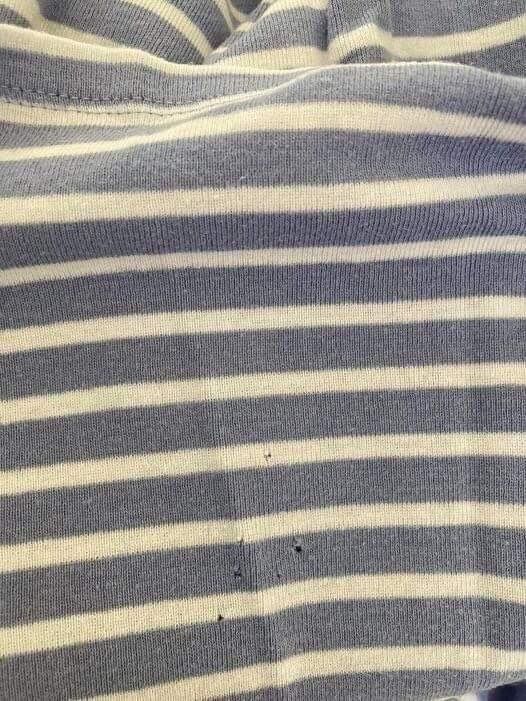Finding a hole in your favorite shirt or jeans can be downright frustrating. But here’s some good news: it doesn’t have to mean the end of your beloved clothing item. Even if you’re not handy with a needle and thread, there are simple, no-sew methods to repair small holes. With just a few materials and a bit of time, you can fix those pesky holes without sewing a single stitch. This guide will show you how to effortlessly repair tiny holes so that your clothes look as good as new.

Common Causes of Holes in Your Clothing
You might assume that moths are the main reason behind mysterious holes in your clothes, but there are several other everyday factors that can cause these tears. Let’s take a look at the most common culprits:
- Zippers: These can snag on delicate fabrics, especially during washing, leading to small rips.
- Bras and Belts: Metal clasps, hooks, and rough belt buckles can rub against clothing, creating friction that weakens the fabric over time.
- Washing Machines: Overloading your washing machine or forgetting to zip up zippers can cause your clothes to snag and tear.
- Chlorine Bleach: While it’s great for brightening whites, bleach can weaken fabric fibers, making them more prone to holes.
- Snags: Rough surfaces like brick walls or wooden fences can easily pull on clothing and create tiny holes.
Tips to Prevent Holes in Your Clothes
To keep your clothes looking new and avoid those unexpected holes, consider these simple preventive measures:
- Be Mindful of Belts and Buckles: If you’re seeing holes near the waistline of your shirts, your belt could be to blame. Try wearing softer belts or even sanding down rough edges to prevent fabric damage.
- Zip Up Before Washing: Always zip up jeans, jackets, and hoodies before tossing them into the washing machine. For bras, fasten the hooks or place them in a mesh laundry bag to prevent snagging other items.
- Avoid Overloading the Washer: Overstuffing the washing machine causes unnecessary friction on your clothes. Keep delicate fabrics like cotton and silk separate from heavier items like towels and jeans, and use a gentle cycle when necessary.
- Use Bleach Alternatives: Instead of using chlorine bleach, which can weaken fabric, opt for natural alternatives like vinegar or baking soda to keep your clothes fresh without the risk of damage.
- Repel Moths Naturally: Moths are particularly fond of wool, silk, and leather. Use dried lavender sachets in your closet or spritz peppermint essential oil to keep them at bay. If you suspect an infestation, wash affected clothes in warm water and clean the closet with vinegar.
- Be Careful Around Rough Surfaces: When walking near brick walls or working with rough wood, be mindful of your clothes. A quick brush against a jagged surface can result in a small hole.
How to Fix Holes Without Sewing: A Step-by-Step Guide
Ready to repair those holes without any sewing involved? This method works best for small holes (around the size of a pencil eraser). Here’s what you’ll need:
Materials Required:
- Clothing with small holes
- An iron
- Fusible bonding web (available at most craft stores)
- Wax paper
Step-by-Step Instructions:
- Prepare the Garment: Lay the clothing item flat on an ironing board with the hole facing up. Smooth out any wrinkles to ensure the fabric is flat.
- Cut the Bonding Web: Cut a small piece of fusible bonding web that’s slightly larger than the hole you’re repairing.
- Position the Bonding Web: Gently push the sides of the hole together, aligning the fabric as closely as possible. Place the bonding web over the hole to cover it.
- Cover with Wax Paper: Place a piece of wax paper on top of the bonding web to protect your iron.
- Iron the Area: Set your iron to the “wool” setting. Gently press it over the wax paper for a few seconds. Lift the iron to check if the hole is sealed. If the hole is still visible, repeat the process until it’s fully closed.
Once you’re done, the hole should be seamlessly repaired. Your clothing will look just like it did before the tear, and no one will ever know it was there.
Why This No-Sew Method Works
You might wonder why this no-sew technique is so effective. The secret lies in the fusible bonding web, which is designed to melt and fuse fabric together when heated. This creates a durable, invisible bond that holds the fabric firmly in place. It’s perfect for fixing small holes quickly without the hassle of sewing.
Share the No-Sew Love with Friends and Family
Now that you know how to fix holes in your clothes without ever touching a needle, why not share this trick? Pass it along to friends and family so they too can extend the life of their favorite clothes. Everyone appreciates a good clothing hack, especially one that saves money and keeps beloved pieces out of the landfill.
Additional Tips for Maintaining Your Clothes
In addition to repairing holes, there are a few other things you can do to make your clothes last longer:
- Wash Less Frequently: Washing clothes too often can wear out the fabric faster. If an item isn’t visibly dirty, consider airing it out or spot-cleaning instead.
- Turn Clothes Inside Out: Before washing, turn garments inside out to protect the outer fabric from friction and fading.
- Air Dry When Possible: High heat from dryers can shrink and damage fabrics. Hang clothes to air dry instead, especially delicate items.
The Bottom Line
With just a few simple tools and a little effort, you can save your favorite clothes from the trash bin. This no-sew method not only repairs small holes but also helps you avoid waste and extend the life of your wardrobe. So, the next time you find a hole in your shirt or jeans, don’t panic—grab an iron, some bonding web, and get to work!
By taking the time to repair rather than replace, you’re not just saving money—you’re also making a sustainable choice that benefits the planet. So go ahead and give it a try. Your clothes (and your wallet) will thank you!





